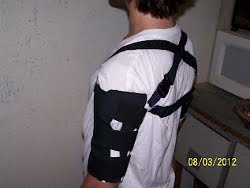Relief in a sling ... a love story
|
|
September 25, 2012 |
By Mike Weland
When a person undergoes and survives an event
that suddenly and profoundly changes life as it
was just moments ago, be it something as
dramatic as a crash or as subtle as a stroke, a
whole new world of learning opens up.
Relearning simple things so easy you don't
remember having ever learned them in the first
place; eating, sleeping. Putting on your clothes
of a morning.
Losing the use of part of you that has always
been there, and suddenly is not, is an
education.
I experienced such an event April 22 when I had
a stroke and lost most of the use of the left
side of me. In less time than the blink of
an eye, who I was before was profoundly and
suddenly changed.
This story, though, isn't about me.
 |
|
Sharon Baker |
It's about a girl in Bunker Hill, West Virginia, who
experienced a stroke just a few days before I
did. Like me, her left side was affected. Like
me, she developed a painful malady that afflicts
most who experienced what she and I have, and
that's a lot of people.
It's estimated that in the U.S., a stroke occurs
about once every 40-seconds. And that doesn't
include all the people who suffer traumatic head
injuries in myriad other ways; car crashes,
shootings, falls and more.
This article, though, isn't about strokes or
head injuries. It's a love story, and a tale of
how small the world has become, thanks to the
Internet. It's about how one man's love for a
woman brought she and I a measure of relief, and
how that relief has the potential to help
millions.
But we'll get to that part in a bit.
In addition to learning how to cope, those who
live through a traumatic brain injury have to
learn a whole new vocabulary; the doctors who treat us
bandy them about but seldom take time to
explain.
"Hemiperesis," is a word few but doctors and
those affected know. It means "weakness on one
side." Another word most never learn is
"subluxation," which commonly occurs in those
affected by hemiperesis, typically in the
shoulder on the affected side.
The shoulder is an amazing joint, allowing great
range of motion when all works as it's supposed
to. But it's also a very delicate joint, held
together by muscle and sinew. When you lose the
muscle, the joint can no longer hold together,
and the weight of the arm inexorably pulls it
apart, resulting in a subluxation, or
dislocation of the shoulder joint, a condition
so painful it affects the sufferer's ability to
sleep or to do the work necessary to regain the
muscle strength necessary for the shoulder to
hold itself together.
With all the people affected and all the
intelligence and ingenuity of those who treat
them, one would imagine that there would have
long since been a range of effective treatment
options for a shoulder subluxation, but one
would be wrong.
In the majority of cases, traditional slings
that hold up the elbow but do nothing to hold
the shoulder together are prescribed, along with
pain medications.
Now to the love story.
 |
|
Robert
Thornton |
Robert Thornton is a craftsman, a man who makes
furniture and unique wood creations at his
home and shop, Level 3 Creations, on Specks Run
Road in Bunker Hill.
When his "soul mate," Sharon Baker, suffered her
stroke April 4, he closed up his busy shop to
spend all his time at her side. Hers was much
more severe than mine; for nearly a week her
very survival was in question. Doctors held out
little hope, telling Robert that if she
survived, she'd likely never regain the use of
her left side.
Sharon did survive, and Robert was there,
helping her relearn how to eat, begging doctors
to hold off putting in a feeding tube for just a
little longer. His devotion paid off; Sharon
recovered enough to be moved to the arduous
rehabilitation floor for intense physical,
speech and occupational therapy. (Don't
misunderstand "occupational;" it's not about
getting a patient back to work, but about
teaching them anew how to do simple, everyday
things; button a blouse, brush your teeth, take
a shower).
Sharon made great progress; every therapy she
underwent, Bob watched, and continued to work
with her in her room. Everything was slowly
getting better, her speech was clearing, her
eating. She was gaining strength in her weakened
leg. Everything except her left arm, which was
too painful to use due to shoulder subluxation.
Robert asked everyone if there were something
that would ease that pain, that would hold her
shoulder together so she could work to regain
the muscle tone needed; all told him that there
was no sling that could do the job; the only
solution was for her to work through the
pain.
He watched as her physical therapist held her
arm in place, giving enough relief that she
could do the exercises, and he began going
through all the different types of slings they
could offer, searching through catalogues and
the Internet. He found that the doctors and
therapists were right; there were none that
would work for the shoulder.
Eventually, Sharon went home and began
outpatient therapy, still suffering the
excruciating pain of subluxation. Robert began
making slings on his own, trying to replicate
what he'd seen her therapist do that day. Every
time Sharon went in for therapy, he had a new
sling to show the therapist, who'd tell him why
it wouldn't work.
He made 10 versions before the therapist agreed
that one showed promise; Robert went back to the
workbench set about refining it; they loved his
11th version, and better yet, when Sharon began
wearing it, the pain diminished to the point she no
longer need pain medications.
 |
|
Elegant in
its simplicity, the final version of
Robert Thornton's hemiperesis
subluxation sling finally accomplished
what he'd set out to do. |
Elegant in its simplicity, Thornton's
hemiperesis subluxation sling allowed Sharon the
full range of arm motion needed for her
exercises. In two weeks, she recovered
80-percent of her arm use and was able to reduce
her time in the sling incrementally as her arm
improved.
Robert donated his sling to the doctors and
therapists who worked with Sharon, and soon
others began asking about it. Robert started
taking orders, donating slings to stroke rehab
centers, and he finally added a website,
https://sites.google.com/site/subluxationsling/,
where people in need of relief can learn more
and order on-line.
Soon after Robert perfected his sling, I
happened across a blurb about it in one of the
stroke survivor chat rooms I now frequent. I'd
been hurting for weeks, and felt that this might
offer some relief. I sent an email for more
information, but my skepticism held me back from
ordering for about a month; the pain getting
worse all the while.
I finally placed my order on-line Monday,
September 17, expecting to wait six to eight
weeks. Instead, I got an email the following
morning saying the sling was on the way; he figured folks who ordered
needed relief as soon as possible, and the sling
arrived on Wednesday. Within two days, the pain
was reduced almost entirely, and I let all my "strokie"
friends on the internet know.
"You have no idea how happy Sharon feels,"
Robert responded. "Every time she reads your
posts it makes her feel better about having a
stroke, knowing what she went through is now
helping others."
In addition to relief, I got two new friends on
the other side of the country, and though we'll
likely never shake hands, I'm very grateful
they're there.
Then, late last week, I got a message from a new
member of the group, a lady who hails from South
Africa.
"Who do I contact to find out about that sling?"
she asked.
I was happy to tell her, and decided to write
this article so others might know as well.
In the meantime, Robert has reopened his shop,
working with wood again when he's not
hand-crafting his amazing slings. Sharon now
works beside him as she can; the work being a
good form of rehabilitation in itself.
The slings are a bargain at $89, not quite $100
when you add shipping and handling. In addition
to the website, you can visit Robert on
Facebook;
http://www.facebook.com/level3creations/info,
or just give him a call at (304) 279-6701. |
|
Questions or comments about this
article?
Click here to e-mail! |
|
|
|
|

